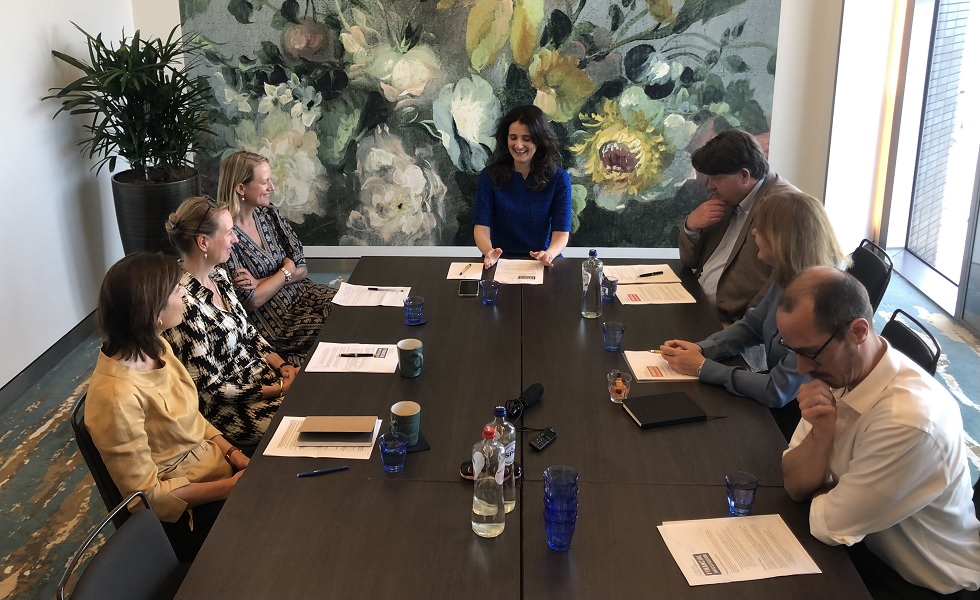Roundtable 'Reducing your Carbon Footprint'

What can institutional investors do to enable companies to reduce their carbon footprint to emission levels agreed upon in the Paris Agreement? Is an occasional push from investors part of the pathway to a substantially smaller footprint?
By Baart Koster
|
Chairman: Jelena Stamenkova van Rumpt, Anthos
Participants: Jacqueline Duiker, VBDO Daniëlle Schoonbrood, DSM Pension Services Cornelia Furse, Fidelity Han Dieperink, Auréus Karlijn van Lierop, BMO Global Asset Management Annette van der Krogt, Achmea Investment Management Joost Notenboom, a.s.r. vermogensbeheer |
In the Amsterdam Doubletree Hilton, overlooking the Open Havenfront of the Oosterdok, seven investment specialists shared their vision on what is needed for the necessary reduction of greenhouse gas emissions. The lively, sometimes almost philosophical debate unfolded around various elements of this theme and was chaired by Jelena Stamenkova van Rumpt. Karlijn van Lierop joined in digitally from her London office. Stamenkova van Rumpt started off by asking what the components of a net zero approach for investors should be. For Van Lierop it essentially boils down to having an approach that is focused on real world impact and real world emission reductions. Engagement plays a very important role too, she added, alongside voting, investing in climate solutions, divestment from low-transition holdings and choosing low-carbon benchmarks.
Annette van der Krogt stated that focusing on what companies do in the real economy is a crucial component. It is therefore important to have good engagements with the companies you invest in. ‘What I would like to emphasize is the connection between the voting and your engagement strategy. We have developed an escalation strategy, so when our dialogue with companies does not lead to sufficient progress, we can decide how to escalate.’
|
Jelena Stamenkova van Rumpt Jelena Stamenkova van Rumpt is the Director for Responsible Investment at Anthos Fund & Asset Management in Amsterdam. She leads RI strategy and integration, focusing on the topic of climate and increasingly on human rights. She helps clients implement the RI approach. Before Anthos, she worked at PGGM, where she was responsible for the Human Rights and Labour Issues Engagement Program and RI Integration. |
Moreover, Achmea Investment Management modified its voting policy last year by making a clear connection between the strategy and the remuneration policy. Van der Krogt continued, ‘If a company does not have a carbon strategy put in their remuneration policy, we will vote against the policy itself and also against the remuneration reports that are granted. Thereby sending a clear message to the board of directors that climate change should be an essential component of their strategy and the remuneration policy.’
Does anybody else want to add an insight in regard to the role and potential of engagement?
Han Dieperink: ‘I think engagement works best if you work together with other parties and you cooperate with, for instance, environmental organisations. Then it will become more of an issue, which will make it a reputational thing for the company. If you hurt companies in their reputation, they are more likely to move in the desired direction – certainly, if you work according to a coordinated plan. Social media are vital in that respect. A negative sort of marketing campaign, will work wonders.’
If you hurt companies in their reputation, they are more likely to move in the desired direction – certainly, if you work according to a coordinated plan.
Cornelia Furse: ‘Especially when you’re dealing with smaller companies or companies that are relatively new to the market, the character of our engagement is very different. Much more advisory. This is very different from engaging with a more mature company that is fundamentally resistant to change.’
Van der Krogt: ‘I think that’s what engagement is about, to have it tailored to the company you’re involved with.’
|
Han Dieperink Han Dieperink is Chief Investment Strategist at Auréus. Prior to that, he was CIO at Rabobank Nederland for ten years and CIO at Schretlen & Co for fifteen years. Dieperink now has more than 25 years of experience in sustainable investing and he is convinced that all negative externalities should be part of the cost price of a product. He is also a Columnist and Strategic advisor to BB Capital, a specialist in private equities. |
Are we relying too much on engagement? Is saying that our intention is to engage and not to divest just some kind of an excuse? What does an effective engagement look like? What needs to be in place?
Daniëlle Schoonbrood: ‘You should have a clear strategy for what you’re going to do when there is no progress, even after engaging with a company. Make it clear how long the period of unsuccessful engagement will be and under which circumstances you are going to divest. These are essential elements in your responsible investment policy. You need to be clear on this, not only on your own behalf but also towards your stakeholders.
Joost Notenboom: ‘There is a clock and that’s the problem, we can’t just continuously engage. I think the latest IPCC reports were quite clear and therefore my main point on this is that a net zero strategy should be based in science.’
We encourage companies to have clear, tangible short-, mediumand long-term targets aligned with the relevant 1.5 degrees pathways.
What are some good practices that you expect to see?
Jacqueline Duiker: ‘First we check if the pension funds in the benchmark have a policy of climate change, which all of them do right now. Then we also assess how specific and ambitious that policy is, and what the targets are. Of course, there is a big difference between, for instance, 2050-targets concerning carbon neutrality and targets connected to actions in the next three to five years. These targets are actually very important. So, we are generally assessing, as it were, through a long term lens, but we also try to make it as specific as possible and so bring it back to short-term actions.’
Van Lierop: ‘2050 is still a long way off and it’s a challenge, really, to make sure you push companies to have the right short-term intermediate goals, and to really make sure that they will be on track. Unfortunately, we often see that difficult situations are sort of back loaded, which we simply can’t afford. As Notenboom already implied, the clock is ticking. What we definitely need are shortcuts by 2030. Therefore we encourage companies to have clear, tangible short-, medium- and long-term targets aligned with the relevant 1.5 degrees pathways. We also check if capex really goes to renewables. It’s essential that targets cover the whole supply chain as Scope 3 emissions are valuable to really understand where a company is heading.’
|
Jacqueline Duiker Jacqueline Duiker is Senior Manager at VBDO and Founder of Future Value Matters. Previously she held various positions at ING Group. She has extensive experience in the forefront of making financial markets more sustainable. Duiker supports, inspires and challenges senior management of companies and financial institutions to integrate sustainability into the core of the organisation. |
Then, Stamenkova van Rumpt wanted to explore what investors can contribute to the creation of an enabling environment to speed up climate investing. For Notenboom the answer lies partly in investing in new technologies, as these need time to mature. This means you need to invest in more illiquid categories, as that is where the new technologies need to come from. ‘As private markets are relatively expensive for us’, Notenboom said, ‘we need an enabling environment where brown and green investments are charged according to their contribution to climate mitigation or adaptation. You first need to get that right to get the money flowing to innovative companies and solutions.’
Duiker believes that investors could also simply accept the fact that climate change is a systemic risk. ‘And so, when making your assessments, you make it a constraint for your financial assessments. So that feeds into actually adjusting your risk-return calculations. That’s something you could also do as an investor.’
The solutions to address 80% carbon (equivalent) reduction exist today, but they need to be available at scale and affordably in order to see broad adoption.
What are the top 3 things that we should focus on in our enabling environment to speed up climate investing for large institutional investors?
Furse: ‘What would make a massive difference here would be to broaden the focus away from Scope 1 and 2 emissions. Scope 1 and 2 emissions are part of every assessment because they are readily available and relatively measurable. But, they only offer a narrow perspective into the environmental impact a company might be having. Take a company making EVs. Scope 1 and 2 emissions tell you the emissions generated to manufacture an EV, but they do not capture the emissions prevented by an EV during its lifetime. Having more data that capture a holistic assessment of what a company is actually doing, would be incredibly valuable. That would offer a more complete picture of the impact these companies are having and enable us to support the enablers of decarbonisation rather than exclude them for generating emissions because they use energy to produce something. Continuing to invest in these companies helps them to reduce their cost of capital, allowing them to raise the capital to expand the capacity they need in order to get EV adoption and all renewables capacity up to a high level. That could indeed be very powerful.’
Van der Krogt wonders what the portfolios will look like once you start using Scope 3, as that creates a shift in sectors that are now in scope in the top three. ‘Take internet companies for example, if they buy a carbon-neutral energy, then they have zero emissions in their Scope 3. That makes a huge change in how we value our companies on how carbon-intensive they are.’ Dieperink then remarked that we have seen some not-so-nice examples from big internet companies in the Netherlands. ‘The Dutch government subsidises alternative energy for these companies with their huge server farms’, he said, ‘whereas fossil fuels remain to be burned by Dutch households. That is not really a positive effect of the engagement and certainly has a negative effect on society.’ The solution lies with the oil companies, because they have the cashflows and the expertise with large scale projects that is needed for a successful transition, Dieperink thinks.
|
Cornelia Furse Cornelia Furse is Portfolio Manager of Climate Solutions and Water & Waste Strategies at Fidelity International. Previously, in her research role, she was responsible for providing equity analysis on U.S. capital goods companies and making investment recommendations to portfolio managers. Furse joined Fidelity in 2010. Before taking on U.S. capital goods coverage in 2018, she looked at US luxury goods, US healthcare and European utilities. |
There are two different ways of looking at this. Some people claim the solution is in the companies that are already there, others claim that we need to build new types of companies and businesses that will bring solutions that help us to drastically reduce carbon emissions. Which one is it? Or does the truth, as often, lie in the middle?
Notenboom: ‘The alignment for the climate mitigation taxonomy of the EU bond and equity markets was estimated recently by the ECB to sit around 1.3 percent (before the inclusion of gas and nuclear) so there do not seem to be many investable options currently in the listed space. So yes, Shell has a lot of money to invest, but so do we. Money doesn’t seem to be the main barrier when it comes to developing new technologies and scaling them up; it’s probably finding the entrepreneur willing to take a risk, and – at present – finding enough capable team members to develop and commercialize their projects. That takes time. You need roughly seven years to develop a fully operational wind farm in the North Sea. That is not to say you should ban existing oil and gas production right now, that would be impossible.’
Dieperink: ‘Well, we should ban new capex on gas.’
The businesses providing the solutions for reducing emissions are absolutely critical to the success of the transition to net zero.
Duiker: ‘Sure, everything is possible. But going on like this is not one of the options, that’s for sure. I think that looking at the capex is important in this respect. Look at what kind of investments a company is making. Where is their money going? How much of it goes to the transition to renewables? How much money is invested and what do those investments actually lead to? So as an institutional investor you have to look at capex when making your assessments.’
Furse: ‘There are two approaches to this problem; most of the discussion today has been about investing in the companies that are reducing their own carbon footprints. But the other side of this coin is investing in the enablers, the companies with the solutions that allow society to reduce its carbon footprint (the wind turbine manufacturers, the building insulation companies). The solutions to address 80% carbon (equivalent) reduction exist today, but they need to be available at scale and affordably in order to see broad adoption, not just by the leading sustainable companies, but by everyone - public, private, state-owned corporations, individuals and so on. The businesses providing the solutions for reducing emissions are absolutely critical to the success of the transition to net zero, and we need to ensure that there is a favourable environment and robust investor support for these types of businesses.’
|
Annette van der Krogt Annette van der Krogt has been Head of Responsible Investment at Achmea Investment Management since 2007. Together with her team, she is responsible for developing and implementing responsible investment strategies for institutional clients. Previously, Van der Krogt worked as a Corporate Governance Analyst at ABN AMRO Asset Management. She is also a member of the Executive Board of Eumedion since 2018. |
So should we look at capex and the extent and intensity of investments in renewables instead of focusing just on whether companies are investing in those technologies or not?
Duiker: ‘Exactly. What you also see now is that many oil and gas companies are selling off parts of their business in order to look better in terms of carbon intensity, but the world is not. And what do they do with the money they receive? Often, they give it back to shareholders instead of investing in the transition. I think it’s good to be critical on that too.’
Dieperink: ‘But that’s an effect of the engagement. You ask those companies to lower their carbon footprint, and that’s just what they do. But in fact, they’re lowering their carbon footprint by selling it.’
Divestment alone won’t help. Re-allocating that freed up capital to real solutions and to companies that are willing and able to scale those, will.
That looks like unintended consequences of engagement.
Dieperink: ‘Not really, because they do what we ask them to do.’
All the more reason to talk about selecting the right companies and funds. How do you do that and what is it that you are looking for? Also, how do you have your discussions when you’re divesting? As now, for example, when we see oil prices going really high, and return is still very important. How do you handle this sort of clash?
Van der Krogt: ‘Our clients are looking for a carbon strategy and our discussions are about whether you should exclude oil and gas companies. The first question I then ask our pension funds is what is their driver for excluding those companies. Is it from a normative or ethical perspective or are risk return considerations in play?’
|
Karlijn van Lierop Karlijn van Lierop is Director Responsible Investment at BMO Global Asset Management and was recently appointed Global Head of REO in April. In this role, she is responsible for Responsible Engagement Overlay, BMO’s engagement and voting program. Prior to that, Van Lierop was Head of the Responsible Investment Department at MN, where she led the ESG team. Van Lierop was a board member of IIGCC and of the Living Wage Financials Platform. |
Notenboom: ‘Often risk-return is a driver.’
Van der Krogt: ‘Indeed! So as soon as you have identified the correct driver, you can start to mobilize your portfolio on that. Most pension funds that we serve still believe that they should not exclude a whole sector. However, they choose to follow another approach. In this approach we measure all the oil and gas and the carbon-intensive companies for these clients to see if these companies have a creditable transition pathway, which we then assess and exclude should that pathway be insufficient. With the remaining leads we start very intense dialogues, monitor them and make very sure that they continue to progress. If they don’t and our escalation policy does not help accomplish that, the company might be excluded. However, as most do, we continue to invest in those companies that are willing and committed to make the transition to net zero in 2050.’
My view is that current events are going to have an extremely beneficial impact on the longer-term drivers towards decarbonisation.
Schoonbrood: ‘All depends on the ambition you have as an investor. When the ambition is to make real world impact, this is not achieved by only looking at the emission history of companies and then, based only on their high emissions, excluding them. When wanting to make real world impact, the carbon reduction strategy and plans of companies and the actual steps they are taking to achieve reduction should be taken into account as well. The capital expenditure of companies is an important indicator of their integrity and for the crucial question: are they doing what they promised they would do? When wanting to make real world impact, encouraging companies via engagement and voting to make the needed change are also important elements. When a company doesn’t take steps to improve and there is no positive change via engagement and voting, divestment ultimately can be a route. However, when a sector is extremely polluting, like the tar sand sector, companies active within these type of sectors often don’t have the ability to become environmentally friendly. For this reason, companies are often excluded when a certain percentage of their profit comes from activities in these type of sectors.’
How do you look at high emitting companies?
Notenboom: ‘As a preparation I looked at our top ten emitting companies, mainly cement, steel and waste or water. It is my belief, however, that we should not have a carbon tunnel vision. Yes, it is wise and prudent from an assurance point of view to look backward at the emission numbers, mentioned in an annual report. But that number doesn’t say anything about the forward-looking capex and about investment decisions, as has been said here before. My problem with the engagement versus divestment discussion is that it focuses only on one side of the coin. Divestment alone won’t help. Reallocating that freed up capital to real solutions and to companies that are willing and able to scale those, will. That’s the approach we have at our company.’
|
Joost Notenboom Joost Notenboom has worked on sustainability within the professional and financial services industry for the past ten years, in the Netherlands and abroad. At a.s.r. asset management, he has been working since 2019 on further developing the SRI policy, selecting sustainable and impact investments, and engaging with companies and external managers on their performance. |
The winners of the future – the IPCC identified mitigation options in all sectors which can halve global emissions by 2030 – are looking for capital now, and we should be spending our time supporting them. Oil and gas are nowadays just a small part of the benchmark and we, in Notenboom’s words, ‘seem to be spending an awful lot of time, brainpower and resources on trying to convince them to join us in the new economy.’
Dieperink added that the problem with the benchmark is that energy may be a small part of it, but that other companies in the benchmark are still consuming around 100 million barrels of oil per day. So then there is still something wrong with the other parts of the benchmark. To which Notenboom replied that you can also form a demand-side engagement plan targeting large users of fossil fuels since, clearly, production-side engagement hasn’t delivered sufficient results. ‘You can go to Big Tech or companies such as Samsung or ASML, for instance, and ask them how they intend to deliver on their net zero commitments if you take away offsets and purchased electricity from renewable sources, which then shift emissions on to other users, as was pointed out earlier. Perhaps there is an opportunity here for more democratization of electricity and heat production, distribution, and storage, where the brainpower, capital and infrastructure of ‘the rest of the benchmark’ is more actively pointed towards speeding up the energy transition.’
It’s very important to not leave out the social component. I think it’s really important to be aware of what this world transition will require from the social aspects.
Do any of you engage with governments?
Notenboom: ‘That’s a bit complicated, because who do you target? Who do you speak to?’
Duiker: ‘Sure there is no clear-cut way that it’s being done, but it’s being done, nonetheless. There are examples of asset managers who are engaging or have been engaging with governments. For instance, in Brazil on deforestation. There are great initiatives there. So, it is possible. And maybe that’s a call to go and find out how you could do it.’
|
Daniëlle Schoonbrood Daniëlle Schoonbrood is Fiduciary Advisor for Responsible Investment at DSM Pension Services, the integral service provider for Stichting Pensioenfonds DSM Nederland (PDN) and Stichting Pensioenfonds SABIC (SPF). Schoonbrood is responsible for advising both pension funds on sustainable investment and is a sparring partner and sounding board for the investment committees and boards in this area. |
Van Lierop: ‘I think it definitely makes sense to engage with governments and talk to them, just to see how they can work out the NDCs. From our company’s perspective, we’ve also always been very active in public policy engagement. So prior to COP26, we were expressing our expectations, joining investor statements, and really reaching out to governments to make sure that the NDCs or the national plans from the governments to be successful in achieving the climate Paris Agreement goals, were sufficient. I think there lies an important responsibility at our doorstep, because we as investors are really one of the stakeholders that can push governments to step up their work.’
Dieperink: ‘I believe you should better engage on organizations like the IMF. If, for instance, you would say that a country is not complying to IMF-standards and should be excluded from the next round of help from the IMF, that would really have an impact on things. You certainly can’t hurt governments by saying ‘I’m not engaging with you and I’m excluding you from my tiny portfolio’. You should see also where the weak spots are, and a weak spot of governments is their reputation in international organizations.’
So, with right carbon pricing the market will give you a solution and it’s certainly the cheapest way to solve this. It will definitely leverage smart, sustainable market innovations.
How do the recent geopolitical events influence all of this? This is where we also have seen the biggest shift in the narrative of oil and the need for it and how things are playing out. Are governments wrong to be subsidising fossil fuels and thereby increasing generation from coal plants in this current crisis?
Furse: ‘Evidently governments can’t deny people the basic need of a warm home. At the same time, they have to maintain their decarbonisation strategies. I do think that in that respect it’s worth disaggregating the short term, how we keep our houses warm, versus the longer term and the impact that current events are going to have on the longer term. My view is that current events are going to have an extremely beneficial impact on the longer-term drivers towards decarbonisation. So the value of renewables is now not only price consistency and price visibility, but also energy security. You know where it’s coming from and you’re not reliant on Putin. But also the payback that you have on any energy efficiency solutions – building insulation, or industrial automation – is much improved. Governments can sort of rally behind this and while the short term is incredibly painful, the longer term, I hope, will be an even rosier picture for decarbonisation.’
Schoonbrood: ‘I think that’s an important one, short versus long term, and to make it a gradual change.’
We should do all we can to make it a just transition. But that gets complicated, because sustainable investments will inevitably bring some unintended effects too.
Notenboom: ‘That is true. Even removing the plastic soup out of our Pacific Ocean has a negative impact on emissions, as you need to get your boats to Hawaii.’
Schoonbrood: ‘True, but I think this is also a journey. We are all learning, and going along this journey we are trying to tackle these climate issues. And yes, this journey has some disadvantages too, inevitably. But learning, adjusting, learning, adjusting is the only way forward.’
Van der Krogt: ‘But it’s also the other way around. If you look at your holistic responsible investment policy or engagement, every single thematic engagement you start; climate change has a certain effect on it. So, it’s interfering in everything. So, today we have to focus on climate change, but if you would have it on labour, for example, climate change will be one of the elements to look at.’
Van Lierop: ‘That is a really good point, and it’s very important to not leave out the social component. I think it’s really important to be aware of what this world transition will require from the social aspects. That is about people and their jobs. We have to make sure there will be proper jobs with proper living wages paid in the new low-carbon economy or net zero company. But we also need to be aware of the inequalities in terms of countries and economies. Specific countries are very vulnerable to the physical climate risk. The impact of climate change on communities and countries might become huge.’
Notenboom: ‘That stresses the importance of looking at the price on carbon. I mean Suriname is one of the two negative emission countries in the world, but they’re about to develop their own oil and gas reserves. If you don’t want them to do that, you will have to pay them.’
Dieperink: ‘Capitalism 2.0 is the solution, because there are external costs on climate that we should internalise into the market. If you let the market do its work right and if you price things right, then, in effect, this is something that you’ll have to be able to solve. So, with right carbon pricing the market will give you a solution and it’s certainly the cheapest way to solve this. It will definitely leverage smart, sustainable market innovations.’
Duiker: ‘The market doesn’t really work well, so we have to change something there, improve the market. And I think one other thing we could do for investors is adjusting the way they look at riskreturn, and taking more notice of investees that really do make absolute reductions or provide solutions for the transition, and actually take into account these impacts. Because pricing, as it is being done now in risk-return, we know it doesn’t work, so let’s upgrade our approach to include real world impacts.’
Thus ended the multi-faceted roundtable discussion in which participants sought ways to not only help shape the transition to substantial carbon reduction but also improve those processes. To conclude the meeting, Stamenkova van Rumpt asked for a final insight from the attendees. It was generally felt that in order for engagement to be successful there is a need to work together as institutional investors. When push comes to shove, united investors can really help to bring about a real acceleration in the reduction of carbon emissions. Also an occasional push from a united front of institutional investors can work wonders in that respect. With the clock ticking, that is a hopeful notion.
|
SUMMARY Engagement works best if you work together with other parties. If you cooperate, for instance with environmental organisations, it will become more of a reputational issue and make it more effective. Engagement has to be tailored to the company you are involved with as an investor. A net zero strategy should be based in science. Targets should cover the whole supply chain as Scope 3 emissions are valuable to really understand where a company is heading. |

















